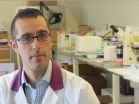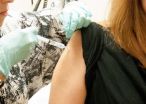Nervous system may play bigger role in infections than previously known
Basic science researchers now trying to decipher 'neural code' of information being sent by neurons
2014-11-27
(Press-News.org) TORONTO, Nov. 26, 2014--The nervous system may play a bigger role in infections and autoimmune diseases than previously known. If researchers can learn more about that role, it could provide insight into diagnosing and treating everything from the stomach flu to rheumatoid arthritis.
Researchers at St. Michael's Hospital in Toronto, in conjunction with the Feinstein Institute for Medical Research in Manhasset, N.Y., reviewed the latest, most vigorous pre-clinical trials on this topic in a commentary published Wednesday (Nov. 26) in the New England Journal of Medicine.
They noted that neurons of the peripheral nervous system - specialized nerve cells that transmit information throughout the body - are known to send information about local infections or inflammation to the central nervous system (the brain and spinal cord) so the CNS can co-ordinate the whole body response.
Dr. Benjamin Steinberg, a post-doctoral fellow and an anesthesiology resident at St. Michael's, hypothesized that the neurons may be sending the CNS not just a general Danger Warning but specific information about whether the infection is caused by a virus or bacteria, the type of bacteria present or the nature of the auto-immune reaction.
Basic science researchers are now trying to decipher that "neural code" of information being sent by neurons.
"The blue sky idea is that if we know the language and can read the code, in theory we can engineer or write our own," said Dr. Steinberg, writing with coauthors Dr. Arthur Slutsky, vice-president of research at St. Michael's and Dr. Kevin Tracey, president of the Feinstein Institute.
Since those messages are being sent from neurons to the CNS in real time, knowing what they're saying could speed diagnoses or prognostication, which would be especially important in pandemics or outbreaks of particularly contagious or deadly diseases, such as flu, Ebola or SARS. The current method for confirming infections is to test body fluids or tissues, sometimes using invasive techniques, a process that can take hours, days or even longer. Moreover, Dr Steinberg said researchers might even be able to tell how severe an infection is and how the illness is expected to progress without treatment.
"Timely diagnosis and intervention are essential to minimize deaths and complications," said Dr. Steinberg. "If the neurons are reading this information from an infection in the blood or the liver and we can interrogate the nervous system, we can make a diagnosis in real time. For example, we could perhaps tell quickly whether someone has the flu virus or bacterial pneumonia, which would determine whether antibiotics would be appropriate. At the extreme, a patient in septic shock requires prompt administration of antibiotic agents since each hour of delay is associated with a 7.6 per cent increase in mortality, but physicians do not always know what bacterium they need to target. An inappropriately chosen antibiotic can have serious ramifications for patient well-being."
It's already possible to intercept and change some messages being sent to the CNS using bioelectric therapy. When injured, pain receptors send messages to the CNS that are registered as pain. Bioelectric therapy relieves pain by interrupting pain signals before they reach the brain. It also prompts the body to produce endorphins, which help to relieve pain.
INFORMATION:
About St. Michael's Hospital
St. Michael's Hospital provides compassionate care to all who enter its doors. The hospital also provides outstanding medical education to future health care professionals in more than 23 academic disciplines. Critical care and trauma, heart disease, neurosurgery, diabetes, cancer care, and care of the homeless are among the hospital's recognized areas of expertise. Through the Keenan Research Centre and the Li Ka Shing International Healthcare Education Center, which make up the Li Ka Shing Knowledge Institute, research and education at St. Michael's Hospital are recognized and make an impact around the world. Founded in 1892, the hospital is fully affiliated with the University of Toronto.
For more information or to interview Dr. Steinberg, contact Leslie Shepherd, Manager of Media Strategy.
St. Michael's Hospital
Inspired Care. Inspiring Science.
http://www.stmichaelshospital.com
Follow us on Twitter: http://www.twitter.com/stmikeshospital
[Attachments] See images for this press release:

ELSE PRESS RELEASES FROM THIS DATE:
2014-11-27
An experimental vaccine to prevent Ebola virus disease was well-tolerated and produced immune system responses in all 20 healthy adults who received it in a Phase 1 clinical trial conducted by researchers from the National Institutes of Health. The candidate vaccine, which was co-developed by the NIH's National Institute of Allergy and Infectious Diseases (NIAID) and GlaxoSmithKline (GSK), was tested at the NIH Clinical Center in Bethesda, Maryland. The interim results are reported online in advance of print in the New England Journal of Medicine.
"The unprecedented scale ...
2014-11-26
ANN ARBOR--The spaghetti-like internal structure of most plastics makes it hard for them to cast away heat, but a University of Michigan research team has made a plastic blend that does so 10 times better than its conventional counterparts.
Plastics are inexpensive, lightweight and flexible, but because they restrict the flow of heat, their use is limited in technologies like computers, smartphones, cars or airplanes--places that could benefit from their properties but where heat dissipation is important. The new U-M work could lead to light, versatile, metal-replacement ...
2014-11-26
MINNEAPOLIS - The majority of people with dementia have never seen a doctor about their memory and thinking problems, according to a new study published in the November 26, 2014, online issue of Neurology®, the medical journal of the American Academy of Neurology.
In the study, 55 percent of the people with dementia had never had an evaluation of their thinking and memory skills with a doctor.
"These results suggest that approximately 1.8 million Americans over the age of 70 with dementia have never had an evaluation of their cognitive abilities," said study author ...
2014-11-26
ANN ARBOR, Mich. -- Despite clear signs that their memory and thinking abilities have gone downhill, more than half of seniors with these symptoms haven't seen a doctor about them, a new study finds.
University of Michigan researchers and their colleagues say their findings suggest that as many as 1.8 million Americans over the age of 70 with dementia are not evaluated for cognitive symptoms by a medical provider, which in some patients can lead to a failure to uncover modifiable causes of thinking or memory impairment.
The study, published online in Neurology, the ...
2014-11-26
Juvenile offenders with multiple psychiatric disorders when they are incarcerated in detention centers appear to be at high risk for disorders five years after detention, according to a report published online by JAMA Psychiatry.
Psychiatric disorders are prevalent among juvenile detainees. However, far less is known about the young people after they leave detention.
Karen M. Abram, Ph.D., of the Northwestern University Feinberg School of Medicine, Chicago, and co-authors looked at patterns of comorbidity (the presence of two or more disorders), how they change over ...
2014-11-26
FLAGSTAFF, Ariz. -- Nov. 26, 2014 -- An international team of scientists from the Translational Genomics Research Institute (TGen) and The Luxembourg Centre for Systems Biomedicine (LCSB) have completed a first-of-its-kind microbial analysis of a biological wastewater treatment plant that has broad implications for protecting the environment, energy recovery and human health.
The study, published Nov. 26 in the scientific journal Nature Communications (DOI: 10.1038/ncomm6603), describes in unprecedented detail the complex relationships within a model ecosystem.
The ...
2014-11-26
Johns Hopkins researchers report that their test of an interventional X-ray guidance device approved by the U.S. Food and Drug Administration in 2013 has the potential to reduce the radiation exposure of patients undergoing intra-arterial therapy (IAT) for liver cancer.
In a report prepared for presentation Dec. 3 at the 100th annual meeting of the Radiological Society of North America in Chicago (abstract #SSM24-02), the researchers described the results of a clinical trial of the imaging system AlluraClarity, made by Philips Healthcare, on 50 patients with liver cancer. ...
2014-11-26
Plasmid DNA attached to the outer surface of a sounding rocket may be able to withstand rocket launch, a period of residence in suborbital space, re-entry, and landing conditions into the Earth's atmosphere, all the while staying intact and active in its function as carrier of genetic information, according to a study published November 26, 2014 in the open-access journal PLOS ONE by Cora Thiel and Oliver Ullrich from University of Zurich and colleagues.
DNA plays an important role as a biomarker for the search of extraterrestrial signatures of life, and scientists are ...
2014-11-26
Potential 'vampires' buried in northwestern Poland with sickles and rocks across their bodies were likely local and not immigrants to the region, according to a study published November 26, 2014 in the open-access journal PLOS ONE by Lesley Gregoricka from University of South Alabama and colleagues.
In northwestern Poland, apotropaic funerary rites--a traditional practice intended to prevent evil--occurred throughout the 17th-18th c. AD. Those of the dead considered at risk for becoming vampires for a variety of reasons were given specific treatment, and investigating ...
2014-11-26
Shifts in the timing and duration of ice cover, especially the possible lengthening of ice-free periods, may impact polar bears under projected warming before the end of the 21st century, according to a study published November 26, 2014 in the open-access journal PLOS ONE by Stephen Hamilton from University of Alberta and colleagues.
Sea ice across the Arctic is declining and altering physical characteristics of marine ecosystems, and polar bears are vulnerable to these changes in sea ice conditions. The authors of this study used sea ice projections for the Canadian ...
LAST 30 PRESS RELEASES:
[Press-News.org] Nervous system may play bigger role in infections than previously known
Basic science researchers now trying to decipher 'neural code' of information being sent by neurons




